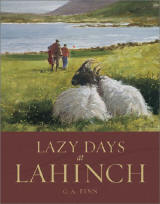Lazy Days at Lahinch
I confess to a weakness for Irish movies.
Years ago, our children were enchanted by The Secret of Roan Inish, and so were we.
We also thoroughly enjoyed Roddy Doyle’s trilogy of modern-day life in Ireland—The Commitments, The Snapper, and The Van. In addition, Ned Beatty and Adrian Dunbar brought two memorable characters to life in Hear My Song.
This year Colm Meany and Dunbar outdid themselves in How Harry Became a Tree.
And now I wish that the Irish Film Board or its equivalent will somehow find a way to create a movie version of Lazy Days at Lahinch.
I can already see Meany and Dunbar as two of the fascinating recurring characters in this great collection of short stories loosely centered around the famous golf course, on Ireland’s west coast in County Clare.
Meany would be great as Bob Dickins, the crafty caddie master. Dickins is a student of human frailty, as well as a man who knows how to make and win a bet. He makes his first appearance in the book “His Lordship”, where some of his qualities are described in colorful detail.
A later tale, titled “Hot Stuff!” is a very funny piece in which Dickins’ ability to size up the opposition for his eventual profit is well in evidence. It’s set in November, when golf is an iffy proposition at best. Then again, some other propositions can still be made.
I’d love to see Dunbar as Father Malachy Murphy, the curate of the parish of Lahinch and Liscannor. We first meet him in “The Road to Damascus,” wondering what will become of his precious time for golfing when a new pastor arrives. Monsignor Pius Ignatius O’Flaherty apparently is not a golfer. Murphy has to figure out a way to change that fact so that his own lifestyle remains as golf-filled as possible.
He’s up to the task, as it turns out.
George Finn creates a wide range of other characters in this collection. With a few deft touches, he opens a window into a little world of its own, in which the familiar dominates and the unusual can cause havoc. That point is made in starkly modern ways in another funny piece called “The Bosnian Bombshell.” Zeelya Izabeghavitch is a 20-year-old refugee from Sarajevo in need of lots of rest and several good meals.
As she recovers, the villagers can’t help but notice Zeelya’s physical attractions. She also shows her own awareness of the attention she can invite without doing much more than simply standing there. An attempt to caddie for her host, Sergeant Tim Twomey, proves disastrous to the foursome’s game as well as to the driving record of a tour bus driver with a load of Japanese tourists.
Not every story merits inclusion in the movie version of the book. On the other hand, some pieces are truly wonderful, and are so visual in the telling that a movie would surely be improved by their addition.
For example, the last story, “The Big Dream,” involves an old Lahinch member, Ollie, sitting quietly in a club lounge chair, sipping his warm toddy. He begins to daydream of his long-lost wife. His mind then wanders to another dream of playing a long par-3 at Lahinch as a young man. The finish can bring tears to one’s eyes.
Here’s hoping that someone takes me up on the suggestion that this book be given a cinematic treatment. These stories deserve a wide audience.
Review Date: December 26, 2002


